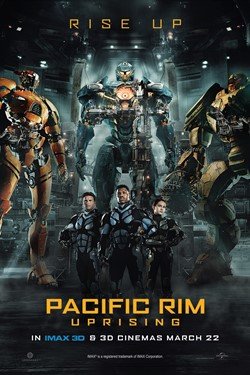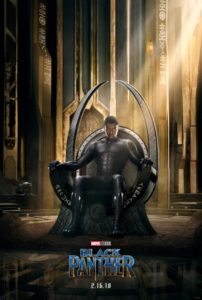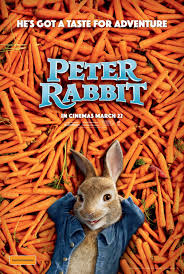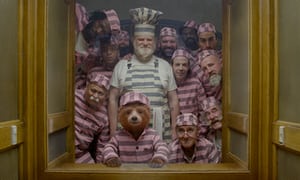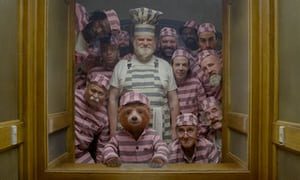Pacific Rim Uprising
Posted on March 22, 2018 at 5:06 pm
B-| Lowest Recommended Age: | Middle School |
| MPAA Rating: | Rated PG-13 for sequences of sci-fi violence and action, and some language |
| Profanity: | Brief strong language |
| Alcohol/ Drugs: | None |
| Violence/ Scariness: | Extended peril and violence with disturbing images, giant robots, alien monsters, explosions, mass destruction, characters injured and killed |
| Diversity Issues: | None |
| Date Released to Theaters: | March 23, 2018 |

I know you’re all eager to hear whether you will understand this movie if you haven’t seen (or, more likely, saw and forgot) the first one. Here is my answer: you won’t understand this film even if you did see and remember the first one and it just doesn’t matter. The first one was about giant robots fighting alien monsters and it ended with Idris Elba giving a great pep talk to the troops and then sacrificing himself to save the world.
Second verse, same as the first. Even bigger robots. Even meaner monster aliens. Even dumber dialogue. Buildings knocked down and shattered as though they were made of eggshells. A volcano. Plus mutant robot monster aliens. A near-feral girl with a gift for creating robots. A pilot with daddy issues.
And, I can’t help it, since it takes two pilots who mind-meld in a process called “drift” to operate the giant robots called Jaegers in perfect synchronization, every time they do it I keep thinking they’re playing Dance Dance Revolution.
That would be only slightly more silly than the actual storyline (hmm, a “Step Up”/”Pacific Rim” crossover — I offer this idea freely, noting that there is a promise of a third chapter at the end of the film).
“Star Wars'” John Boyega (who also co-produced) plays Jake, the son of the Idris Elba character. As he explains in a striking opening scene, the world has in some ways returned to normal after the defeat of the Kaiju monsters, though their enormous skeletons are still a reminder of the fight, one right next to the pool where Jake is enjoying a life of girls and parties. He has no interest in following in his father’s footsteps as a pilot or a hero. Like his “Star Wars” pal Rey, he is a scavenger, looking Jaeger robot junkyards. But things go wrong when a helmeted motorcycle rider steals the special part he promised to some very unforgiving guys. I note here the famous Roger Ebert rule that a mysterious helmeted figure will always turn out to be female. Yes, Amara (Cailee Spaeny) is not only female but young, and a Shuri-like tech whiz who is building her own Jaeger. The two of them end up in jail, and then, of course, sent to pilot training. “Ender’s Game”-style, younger recruits are taken because they are better at drifting.
When they arrive, Amara excitedly recognizes all the various Jaegers as a way of reintroducing us to them, and, discovering who Jake is, reminds us again that his father was a hero and he is not too happy about that. The tough, this-is-serious-business commanding officer is Nate (Scott Eastwood, channeling his dad), who says things like, “You and I both know you could have been great.”
There’s also a lot of “We need it now.” “It can’t be done.” “Do it anyway” “I need more time!” “We don’t have any!” “You got this!” “Let’s do this!” “Will it work?” “One way to find out!” talk and a lot of “20 kilometers to impact” military/tech language. And Jake says he can’t give a pep talk like his dad but he does. Does it include “This is OUR time!” Yes, it does.
The good thing is that the movie does not just know how silly it is — it embraces the silliness. The better thing is that it has EVEN BIGGER ROBOTS fighting EVEN BIGGER MUTANT ROBOT ALIENS! No matter how dumb it gets, no matter that the robots and monsters have more personality than the humans, no matter how much it seems like a mash-up of “Transformers,” “Ender’s Game,” “Starship Troopers,” and anime, it is undeniably fun to see robots bashing monsters, and thankfully there isn’t much in between the battles to slow things down.
Parents should know that this film includes extended and sometimes graphic peril and violence, many characters injured and killed, chases, explosions, scary monsters, some disturbing images, sad death of parents, issues of sacrifice, brief strong language, brief crude humor
Family discussion: Why did Jake insist that he was not like his father? How do you think the drift works? How do you prevent being defined by other people?
If you like this, try: The first “Pacific Rim,” “Ender’s Game,” and “Starship Troopers”

